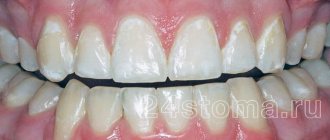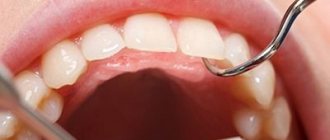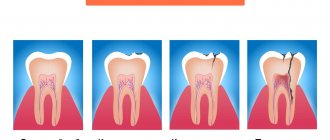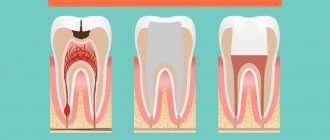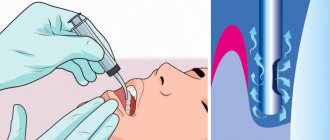An inflammatory formation affecting the upper part of the tooth root is called granuloma. It is formed during the development of periodontitis. Tooth granuloma is tightly attached to the root, being the initial stage of a granular cyst (cystogranuloma), from which it differs, in fact, only in its slightly smaller size. If the formation is ignored and not treated, it will begin to increase.
Tooth granuloma: symptoms of the disease
Only a doctor can make a diagnosis based on an x-ray, where a darkening will be visible in the root area. Any darkening in the image is a sign of the presence of a cavity, but if a granuloma occurs, it means that periodontitis, which is chronic in nature, begins to develop.
For a long time, the tooth may not bother a person at all. Sometimes pain may occur when biting or when eating hot food: these are the first signs of the development of chronic periodontitis. An exacerbation of the disease is observed during periods of weakening of the body's immunity: then the pain intensifies significantly, which is especially noticeable when biting. During such periods, as a rule, the gums become swollen, and in the area of inflammation it becomes painful to touch.
Why does granuloma appear on the root of a tooth?
At the tops of the roots, such formations can appear for several reasons:
- Poorly performed treatment of pulpitis. If caries is started, the affected cavity gradually becomes quite deep. When microorganisms enter the pulp, its inflammation begins, accompanied by acute pain, which may stop over time, indicating the death of the nerve.
But the development of the disease does not end: bacteria through the root canals extend beyond the boundaries of the affected tooth, as a result of which a focus of inflammation appears near the upper parts of the roots, called periodontitis. The further course of the disease can occur according to several scenarios, one of which is the formation of granuloma.
It is necessary to understand that a tooth with a granuloma does not necessarily have to be affected by caries, since the root can become inflamed near a tooth that has already been treated. If the doctor has not completely removed the tissues affected by caries by placing a filling on top of them, then there is a high risk of developing pulpitis with the subsequent formation of granuloma.
- Filling of root canals performed with violations. A granuloma that appears on the root of a tooth whose canals were filled some time ago indicates the unsatisfactory quality of the procedure performed. Due to inattention, haste or inexperience, the doctor could not fill the canals to the very top. Dentists often refuse to admit their own mistake, because in this case they will have to treat the tooth for free. Such unfortunate specialists can evade until the last minute, pretending that they do not understand the causes of pain, recommending taking a course of antibiotics.
Examples of canine restoration when only the root remains of the tooth
Example 4. The pin in the root of the lower tooth was removed, and the canine itself was restored
In this clinical case, I was restoring the lower canine, and the task was to save the root of the tooth and restore the coronal part of the canine, which was almost destroyed by caries. The anterior wall of the lower canine was made in the form of a filling, and it fell apart from the cutting edge.
As you can see in the photo, an anchor pin was installed inside the tooth - this is a pin that is screwed into the canal to strengthen the tooth. The tooth under the filling and the root of the lower canine were affected by caries. When the carious tissue was removed, only the root and a small part of the wall
:
You and I remember the main topic of our article, which tells us the following - if the tooth root remains, it can be completely restored. And this is not the first time that the unique Cerec technology has come to our aid. Using it and digital scanning, we restored the missing tooth module, which also included the root part:
Next, we restore the lower front tooth using a CEREC inlay and get an excellent result - the lower canine is completely restored:
Example 5. The root of the tooth under the crown of the upper canine has not rotted, and therefore the tooth is 100% restored
In this case, there was a total restoration of the dentition (veneers and crowns) with the replacement of worn-out crowns on the front teeth. One of the upper canines under the crown was seriously affected by caries, but its root was practically healthy - only a small part of the tooth root was damaged, see the following photo:
The missing “crown + root” module and new crowns were manufactured in a laboratory. In general, everything is in a smile, it looks just great:
And the owner of a new beautiful smile herself cannot hide her admiration:
All the main tasks in this total work were successfully solved, but the main thing you should pay attention to is that we managed to save the tooth root here too.
Diagnosis of granuloma on the tooth root
At the early stage of development of the disease, it will not be possible to notice any visual changes. The first signs of pathology become noticeable as the size of the infected area and the amount of pus increase.
To treat the disease with therapeutic methods, it is necessary to examine the affected area in detail: a complete picture of the granuloma must be obtained, which will allow one to detect key signs of the disease that differ from other diseases.
When suppuration occurs, the gums become very red and swollen, and pain appears, which can radiate to the head area in general and the ear in particular. This is the first symptom that should make you wary.
The following methods can be used to make an accurate diagnosis:
- use of classical x-rays;
- the use of radiovisiography or, in simpler terms, computer x-ray.
In the picture, the affected area looks like a dark spot with a clear border in the upper part of the tooth. The size of the spot indicates the following:
- 5-8 mm – the probability of having a dental granuloma is high;
- more than 8 mm – formation in the form of a cyst.
In rare cases, a large granuloma, up to 1.2 cm in size, may occur. Therefore, X-rays may not be enough for diagnosis: it is recommended to perform a biopsy of tissue cells from the area affected by the disease.
In most cases, granuloma is discovered during treatment of other dental diseases: the doctor may pay attention to increased swelling and swelling of the gums. In addition, the bone tissue near the top of the tooth may also bulge.
An increased risk of developing granuloma is observed in patients with crowns and pulpless teeth. Such people are advised to undergo regular examinations in order to promptly identify any changes affecting the gums and teeth.
Material and methods
To identify patterns in the display of CC, including sealed ones, 374 intraoral periapical radiographs, 53 orthopantomograms (OPMG), 47 CT scans before and after endodontic treatment of 194 patients were studied. Under experimental conditions, 127 intraoral periapical radiographs, 26 radiographs using a parallel technique, 32 OPMG, 1434 CBCT sections were performed on skeletonized jaws with teeth.
CBCT data were compared with the results of endodontic treatment, intraoral imaging and OPMG. The influence of the informativeness of radiological techniques on the quality of endodontic treatment was determined, taking into account the time spent on detecting CD of teeth.
The X-ray examination techniques used were applied according to generally accepted rules of survey geometry.
Intraoral radiography was carried out using dental devices Minrey (Finland) and Heliodent DS (Germany), orthopantomography - using Proscan (Finland) and Orthophos XG5 DS Ceph (Germany) devices. Cone beam computed tomographs New Tom 3G (NIM SrI, Italy) and Vatech Pax Reve 3D (E-WOO Technology, Korea) were used. The shooting conditions on these devices complied with the manufacturer's recommendations.
Tooth granuloma: treatment
Usually treatment is only therapeutic in nature, but its strategy may vary depending on whether the canals have been filled before.
- If the canals have not been filled, the tissues affected by caries are drilled out, and the old filling is removed. This is required to carry out high-quality mechanical treatment of the canals, which are expanded and treated with antiseptic agents. If the granuloma is small (formations up to 3 mm are considered such), then the canal is sealed immediately. If the size of the granuloma exceeds 3 mm, the treatment period increases, since it is necessary to put a medicine into the canal, which includes potassium hydroxide - this substance leads to a decrease in the granuloma or even to its complete disappearance. A temporary filling is placed for the period the medication is placed (approximately 2-3 weeks). Then a repeat x-ray is taken, which should clearly show a significant reduction in the inflammatory formation. If the dynamics are obvious, the canals are sealed and a permanent filling is placed.
- If the canals have been filled, then the first stage of treatment is their unsealing. The further sequence of actions is similar to that described in the previous paragraph. The only thing is that if there is a crown on the tooth, it will have to be removed, and after the treatment is completed, it will have to be made and placed again. Some patients do not want to spend money on re-installing a crown: the solution is to perform a root resection operation, when the upper part with the granuloma attached to it is cut off through a small incision in the gum.
Clinic doctors
If you have extensive carious lesions on your tooth or inflammatory processes (pulpitis, periodontitis), then, unfortunately, removal of the nerve from the diseased tooth cannot be avoided. And at the same time, filling the canals. Root canal filling is a complex and responsible procedure. And not only because the doctor must carry out all manipulations with high precision and caution.
Even if the operation went without surprises, after a while you may encounter very unpleasant complications.
And in 60%-70% of cases, the cause of these complications is poor-quality canal filling!
The consequences of such treatment may be:
- severe toothache due to “overfilling” - when excess filling material extends beyond the upper border of the canal;
- gumboil, the development of acute abscesses, the appearance of cysts on the tooth due to “underfilling” of the canals - then an infection develops in the voids of the canal;
- complete tooth removal , which is caused by inaccurate treatment of the canals before filling and perforation of the root wall.
First of all, let's figure it out -
What difficulties may arise at each stage of canal treatment?
This way you will understand what the dentist does and in what order, and for what reasons complications arise.
After all, the tools and materials that the doctor uses directly affect the success of the entire operation. A minor mistake and the whole procedure will have to start all over again.
In modern dentistry, all manipulations are performed under anesthesia.
1. First of all, the doctor removes the tooth tissue affected by caries.
To open access to the root canals and pulp, diseased and (partially) healthy tissue must be removed.
To do this, the doctor drills the tooth in the same way as when filling.
2. After this, you need to remove the tooth pulp.
This is a bundle of nerves that fills the crown of the tooth and the canals themselves.
It is important to remove the pulp completely, because it is incomplete removal of the nerve that often leads to prolonged pain.
3. Determine and record the length of the root canals.
This is an important stage of treatment, because the correct filling depends on how accurately the doctor determines the working length of the canal.
Incorrectly determined canal length is the main cause of all the complications that you already know.
An unfilled or insufficiently densely filled canal, in the remaining space of which bacteria can multiply.
In this case, you need to reseal the canals as quickly as possible. Otherwise, you risk losing your tooth!
Filling material (gutta-percha or paste) that extends beyond the root apex can lead to severe pain for a month (!) after surgery.
In some cases, the pain will go away on its own, while in others, resection of the root apex and removal of excess material will be required.
In their work, specialists at our clinic use high-precision methods for measuring the length of canals:
- X-ray - based on X-ray images;
- electrometric - using special apex locator devices;
- a combination of both methods.
Today, using an apex locator together with x-rays is the most accurate way to determine the length of the canals.
In this case, much fewer x-rays are needed for diagnosis, which means that your treatment will be more relaxed and comfortable.
Too much canal treatment can lead to post-operative pain. Therefore, having accurately determined the length and shape of the canal, DentaBravo specialists fix it with a limiter, after which all manipulations are carried out within this length.
4. Now let's move on to processing the channel.
As a rule, the channels are too narrow, and their walls have unevenness. Therefore, before filling, the doctor expands and aligns them in order to evenly fill them with filling material.
Our clinic specialists use two types of mechanical canal treatment:
- using hand instruments that the doctor himself rotates in the root canal;
- machine processing using endodontic tips and a special device.
In our work we use both techniques, but we recommend machine processing. In our clinic, the latest tools are used for canal treatment - nickel-titanium files (tapers):
- more flexible and therefore suitable for processing the most complex curved channels;
- more durable , and therefore safer - because they will not break off inside the tooth and the fragments will not damage the tissue;
- more effective due to their special shape, so they clean the channels better.
In addition, in our clinic this is where doctors are extremely careful to prevent such complications.
Careless movement of the instrument can lead to perforation of the canal wall and then the filling material will get inside the bone tissue.
If measures are not taken immediately, further treatment of this tooth will be ineffective!
After preparing the canals, they are treated with antiseptics and filling begins.
5. At this stage, the canals are filled with filling mass.
There are several methods for filling canals, but we will look at the most common of them - the lateral condensation method.
The root canal is filled with a special paste (sealer). Then gutta-percha pins are inserted - first the main one, and then additional ones. As a result, from 8 to 12 pins are tightly placed in one channel.
6. Final control of the filling is carried out and excess gutta-percha is removed.
At the DentaBravo clinic, they first use an X-ray to check that the material densely fills the entire canal. And only after this the remains of gutta-percha protruding above the mouth of the canal are cut off.
7. A temporary filling is installed.
Immediately after filling the canals, the crown of the tooth cannot be restored, so it is carried out at the next visit to the dentist.
And finally, the most important thing...
How can you make sure that the canals are sealed correctly?
There are only two ways.
1. Focus on your own feelings.
You should be wary:
- pain that does not go away after several days;
- excessive tooth sensitivity and discomfort while eating;
- any changes in the color and density of the oral mucosa.
However, pain may be an individual reaction and a variant of the norm, so be sure to consult a doctor. And best of all→
2. Take a control x-ray.
From the image, you can even independently determine how well the dentist did his work, whether there are voids or excess material in the canals. It is clearly visible in the photographs: the sealed canals have a bright white color.
And to finally calm down, come for a free consultation at our clinic with pictures. It’s possible without them - after all, we also have our own state-of-the-art X-ray machine, with which we can check the quality of the previous treatment in a few seconds!
Or immediately in order to fill teeth using 100% reliable methods, using modern equipment and an experienced doctor.
Sign up for a free consultation at the DentaBravo clinic!
Granuloma between tooth roots: treatment with antibiotics
The number of people putting off visiting a doctor until the last minute is large. There are many reasons for this: fear of pain (although modern means of anesthesia make it possible for the patient to feel nothing at all during treatment procedures), lack of free time, and reluctance to part with money. But all these reasons and excuses come to naught when the pain becomes unbearable, becoming chronic. As practice shows, as soon as a person does not sleep for a couple of nights, the issue of the need to visit the dentist is resolved by itself.
However, many people try to cure granuloma on their own using strong antibiotics, which is basically impossible. Antibiotics may be prescribed to relieve inflammation and stop the formation of pus, but nothing more. But the action of antibiotics may not affect pathogenic microorganisms located in the root canals, and it is the infection in their unsealed areas that is the only reason for the formation of granulomas.
If a patient comes to the doctor with a suspicion of granuloma, and the doctor, driven by some of his own considerations, does nothing, recommending taking antibiotics, it is better not to delay time, but to immediately contact another dentist. Some doctors simply do not like to re-treat someone’s poorly treated teeth, since repeating the same operations takes much more time, while others, if the patient comes back again, do not want to admit that they made a mistake, which for them is tantamount to realizing their own lack of competence.
How is tooth root removal done?
Are there any features or important points when removing a tooth root? Of course, any removal - be it tooth extraction, wisdom tooth removal, impacted tooth or tooth root should be carried out as atraumatically as possible, preserving the tissue structure
that surround a tooth or tooth root:
The goal of atraumatic root removal is to preserve bone
. Removal should be done painlessly.
The clinics of the German Implantology Center are supporters of atraumatic and painless removal. Our technologies have been proven over the years, and our patients feel very comfortable with them. It is no secret that many patients have fears about removal, and these fears sometimes postpone the surgical stage of treatment for a long time. In our clinics, we help patients overcome these fears. The patient may not be afraid of anything - both in the case of a single extraction and in case of multiple extractions of teeth
:
Tooth granuloma: surgical treatment
If therapeutic treatment does not help, then surgery comes into play: the operation is performed in the presence of a destructive process affecting the gums, and anesthesia (both general and local) is used to carry it out.
There are several surgical treatment options.
Root resection
Elimination of granuloma occurs in several stages:
- a passage to the top of the tooth opens by peeling off the gum shell;
- the root canals are cleaned and subsequently filled with medicinal substances;
- excision of the granuloma is carried out;
- the area is filled with synthetic fabrics;
- the tooth is filled.
On average, the operation takes about an hour.
Hemisection
If a tooth has many roots, then this procedure is prescribed (if there are complications that prevent the root from being saved).
The treatment procedure includes:
- removal of roots under the crown;
- filling the empty space between the roots with a special dental product;
- installation of a crown;
- monitoring the condition of the tooth using x-rays.
The method is simple, while the functionality of the tooth is preserved. If necessary, some time after the procedure, the patient can resort to prosthetics, provided that the root system remains healthy.
Cystotomy
The method is used when removal of large granulomas is required.
To implement it:
- a channel is created between the affected area and the oral cavity, through which pus absorbed by tampons is removed;
- after cleaning, the cavity is treated with antibacterial agents;
- sutures are placed;
- the cavity, free from suppuration, is filled with bone cells.
Is implantation possible after tooth root removal?
Yes, of course it is possible. And we at the clinics of the German Implantology Center widely use implantation after tooth root removal. Our conditions allow us to carry out implantation in such cases. And if we can achieve primary stability of the implant, then in 90% of cases
After removal, we immediately install the implant. We have rolled out the technology to perfection and gives excellent results.
Of course, with the exception of wisdom teeth, no implant is placed after their removal. But, by the way, wisdom teeth in this situation can be extremely useful, since they... can be transplanted to the place of the problem tooth being removed! Dental transplantation has been practiced in the clinics of the German Implantology Center since 2017, and our specialists have accumulated a wealth of clinical experience. Let's talk about this a little more.
Measures to prevent granuloma after an extracted tooth
Preventive measures are aimed at preventing the development of the disease. They include:
- high-quality cleaning of teeth and gums on a daily basis;
- timely treatment of bleeding gums;
- regular visits to the dentist at least once a year (it is better to do this twice);
- replacing toothbrushes (old brushes accumulate bacteria that can provoke the development of the disease);
- contacting the dentist at the slightest pain associated with the gums or teeth;
- treatment of caries, periodontitis and pulpitis - quite often these diseases are the catalyst for the development of granuloma;
- the use of medicated toothpastes and herbal decoctions for rinsing;
- eating foods rich in calcium and other trace elements.
Complications after granuloma at the site of an extracted tooth
Lack of timely treatment and hope that the disease will go away on its own is fraught with serious consequences. Among the most common complications it is worth highlighting:
- development of periodontitis and further formation of a fistula;
- the occurrence of alveolitis is a consequence of the presence of an inflammatory process;
- formation of purulent flux;
- suppuration of the perimaxillary tissue;
- entry of pathogenic bacteria into the lymph nodes, from where they penetrate the cardiac system and internal organs (kidneys, liver and brain);
- development of facial asymmetry;
- the emergence of new foci of infection;
- infection of the body due to the penetration of pathogenic microorganisms into the blood vessels.
Timely removal of granuloma is a guarantee to avoid unpleasant health consequences.

